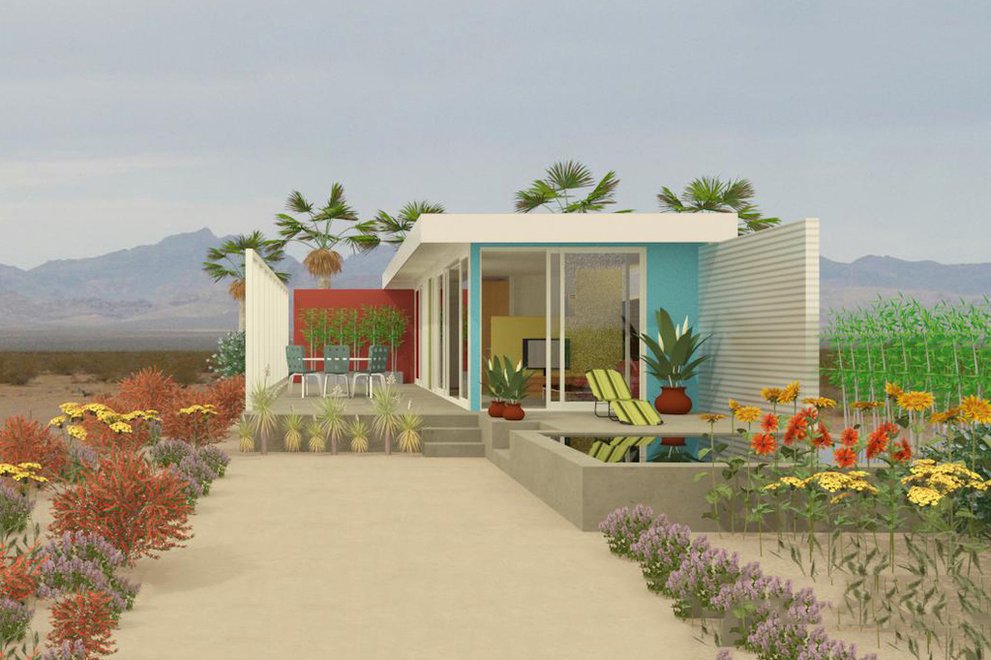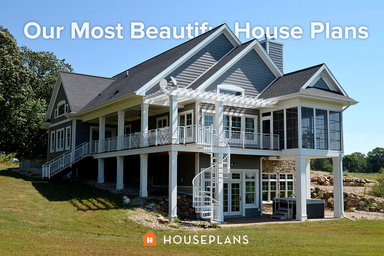Some designs just make you want to jump up and say: "Eureka! I have found it!" I'm quoting the California state motto -- the best way for me to register my enthusiasm for these four very appealing little 400 sq. ft. houses by architects Ron Sakal and Sallie Hood of The Homestead Partners. Ron and Sallie are the newest members of our Signature Plans Studio.
Each California-inspired house has a full kitchen and bathroom, private bedroom with space for a queen-size bed, living/dining/kitchen that opens to an outdoor dining patio or terrace, and plenty of storage. These designs would make excellent starter homes, granny units, and in-law suites. As the architects write: each is "big enough to have a friend over. Just
make sure you're in love with them first." Plan 917-2, called the San Rafael, shown above, recalls Eichler tract houses of the 1950s and 1960s, which were built in both Northern and Southern California -- like this classic example by Jones & Emmons (photo via midcenturymodernfreak.com).
Such homes are now experiencing a resurgence of interest. The large long beams, shallow gable, and glass eave are signature features -- Ron and Sallie have simply adapted and miniaturized them. Here's their San Rafael layout.
They cleverly split their gable and floor plan down the middle so that one half comprises an outdoor living room running the length of the house. They explain: "There was more than one way to translate the ranch house into housing during the 1950s. The peaked roof and floor-to-ceiling windows look became thousands of subdivision tract homes, the best of which are still fabulous. You'll also recognize it as the prototype for scores of restaurants and cafés scattered throughout California, most famously the original Tiny Naylor's at La Brea and Sunset. Ours could be a five-stool diner if you insist, but then where would the guests sleep when dinner was over? Hint: on the porch if you build it somewhere with the right climate."
In Plan 917-4, called the Santa Cruz, Ron and Sallie wrapped a simple wood, gable-roofed structure witha generous porch for casual indoor-outdoor living. The bathroom is at the rear and both bedroom and living/dining/kitchen open to the covered outdoor space with its gas grille in one corner.
The design draws inspiration from the early work of William Wurster, who, with Cliff May, helped popularize the modern ranch house. This influential ranch house design from 1928 is one of Wurster's best known.
It has four bedrooms and is L- shaped but as Ron and Sallie say: "Ours is smaller but still true to the spirit of Wurster’s “living porches” designs that so successfully blur the distinction between inside and out." I would agree.
Plan 917-3, called the Santa Barbara, looks for inspiration to the Spanish Colonial Revival architecture of
Southern California and the Southwest, which was distinguished by red terra cotta tile-covered gable roofs and thick whitewashed walls of plaster or stucco over concrete block or adobe. Here's a doorway detail from the historic Casa del Herrero
in Santa Barbara designed by George Washington Smith and completed in 1925, so you can see the family resemblance in the arched opening, colorful tile work, and thick walls (photo courtesy casadelherrero.com). In other words: "Hello, grand and stately ancestor! Meet your eager toddler descendant!" The compact one bedroom layout of Plan 917-3 is a little wider than
the others in the series, and like them includes generous outdoor living space beside the two major rooms. Combine several of these little cottages together and you'd have your own family compound or bungalow court.
The last California micro cottage design -- shown here and at the top of the post, Plan 913-1, called the Rancho Mirage,
is more strictly modern with a flat roof and lots of glass. The galley kitchen includes a peninsula for
dining, and each of the two main rooms has windows on at least two sides for abundant daylight. According to Ron and Sallie, the genetic source code for this design is the work of pioneering Palm Springs
architect Albert Frey, especially in the two houses he designed for himself -- the photo above shows Frey House 1, completed in 1943 as an abstract composition of wall and roof planes (photo courtesy en.wikiarquitectura). I can also see connections
to Richard Neutra's Kaufmann house of 1948, shown here in a photo by Joe Fletcher for Marmol Radziner.
You could call Ron and Sallie's design a Palm Springs offspring!
It's great to welcome these delightful, efficient, and architectural history-savvy homes into the Houseplans.com family.
To see a collection of original Eichler plans click here.
To see an original Case Study House design by William Wurster click here.
Each California-inspired house has a full kitchen and bathroom, private bedroom with space for a queen-size bed, living/dining/kitchen that opens to an outdoor dining patio or terrace, and plenty of storage. These designs would make excellent starter homes, granny units, and in-law suites. As the architects write: each is "big enough to have a friend over. Just
make sure you're in love with them first." Plan 917-2, called the San Rafael, shown above, recalls Eichler tract houses of the 1950s and 1960s, which were built in both Northern and Southern California -- like this classic example by Jones & Emmons (photo via midcenturymodernfreak.com).
Such homes are now experiencing a resurgence of interest. The large long beams, shallow gable, and glass eave are signature features -- Ron and Sallie have simply adapted and miniaturized them. Here's their San Rafael layout.
They cleverly split their gable and floor plan down the middle so that one half comprises an outdoor living room running the length of the house. They explain: "There was more than one way to translate the ranch house into housing during the 1950s. The peaked roof and floor-to-ceiling windows look became thousands of subdivision tract homes, the best of which are still fabulous. You'll also recognize it as the prototype for scores of restaurants and cafés scattered throughout California, most famously the original Tiny Naylor's at La Brea and Sunset. Ours could be a five-stool diner if you insist, but then where would the guests sleep when dinner was over? Hint: on the porch if you build it somewhere with the right climate."
In Plan 917-4, called the Santa Cruz, Ron and Sallie wrapped a simple wood, gable-roofed structure witha generous porch for casual indoor-outdoor living. The bathroom is at the rear and both bedroom and living/dining/kitchen open to the covered outdoor space with its gas grille in one corner.
The design draws inspiration from the early work of William Wurster, who, with Cliff May, helped popularize the modern ranch house. This influential ranch house design from 1928 is one of Wurster's best known.
It has four bedrooms and is L- shaped but as Ron and Sallie say: "Ours is smaller but still true to the spirit of Wurster’s “living porches” designs that so successfully blur the distinction between inside and out." I would agree.
Plan 917-3, called the Santa Barbara, looks for inspiration to the Spanish Colonial Revival architecture of
Southern California and the Southwest, which was distinguished by red terra cotta tile-covered gable roofs and thick whitewashed walls of plaster or stucco over concrete block or adobe. Here's a doorway detail from the historic Casa del Herrero
in Santa Barbara designed by George Washington Smith and completed in 1925, so you can see the family resemblance in the arched opening, colorful tile work, and thick walls (photo courtesy casadelherrero.com). In other words: "Hello, grand and stately ancestor! Meet your eager toddler descendant!" The compact one bedroom layout of Plan 917-3 is a little wider than
the others in the series, and like them includes generous outdoor living space beside the two major rooms. Combine several of these little cottages together and you'd have your own family compound or bungalow court.
The last California micro cottage design -- shown here and at the top of the post, Plan 913-1, called the Rancho Mirage,
is more strictly modern with a flat roof and lots of glass. The galley kitchen includes a peninsula for
dining, and each of the two main rooms has windows on at least two sides for abundant daylight. According to Ron and Sallie, the genetic source code for this design is the work of pioneering Palm Springs
architect Albert Frey, especially in the two houses he designed for himself -- the photo above shows Frey House 1, completed in 1943 as an abstract composition of wall and roof planes (photo courtesy en.wikiarquitectura). I can also see connections
to Richard Neutra's Kaufmann house of 1948, shown here in a photo by Joe Fletcher for Marmol Radziner.
You could call Ron and Sallie's design a Palm Springs offspring!
It's great to welcome these delightful, efficient, and architectural history-savvy homes into the Houseplans.com family.
To see a collection of original Eichler plans click here.
To see an original Case Study House design by William Wurster click here.






